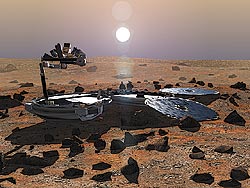
Although it weighs just 30 kilograms, the clamshell-like Beagle 2, which will travel to the red planet with the European Space Agency's Mars Express spacecraft, is well equipped to study Martian rocks and dust. Its planned landing site is Isidis Planitia, an ancient impact basin.
Copyright 2002 Beagle 2.
The European Space Agency's Mars Express mission lifted off today from Kazakhstan — the first of three missions to the red planet scheduled to launch this month. The spacecraft is Europe's first to Mars, and is part of a project similar to NASA's former "better, faster, cheaper" approach of designing and building planetary probes. The project cost about $300 million and was ready for space in four years, in time to make a relatively quick hop to Mars as the planet comes its closest to Earth in 60,000 years.
Six days before arrival at Mars in December, the spacecraft will release a lander — dubbed Beagle 2. A heat shield and parachute will lower the lander to the ground, and Pathfinder-style airbags will cushion the impact. Beagle 2 will touch down on Isidis Planitia, located northeast of Syrtis Major at 10.6° north, 270° west. The hope is that the sedimentary plain at Isidis preserves evidence of ancient Martian life, while being warm enough during local spring for Beagle 2 to survive. Instruments will spend at least six months looking for water, carbonate minerals, and organic material, as well as studying the site's environment.
Meanwhile, Mars Express itself will settle into Martian orbit, where it will study the planet's surface and atmosphere for two years. Its complement of instruments includes a stereo camera, a subsurface sounding radar/altimeter, and a spectrometer.
Mars Express leads an armada of lander-bearing spacecraft. Two NASA missions are scheduled to liftoff on June 8th and 25th, each carrying a Mars Exploration Rover. They will arrive at Mars in January.
 0
0
Comments
You must be logged in to post a comment.